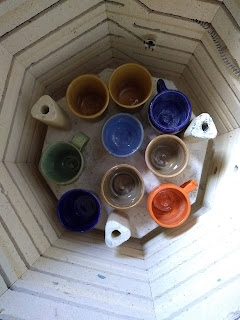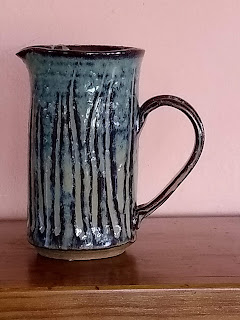Here is this morning's set of gifts.
The top layer, revealed as the lid of the cooled kiln comes up.
Yes, like kids at Christmas, you wait for the kiln to cool, before putting hands on pots. At cone 5, the temperature I use for glaze firing, the inside of the kiln is at about 2200 degrees when it shuts off. I wait!
And then, unload. The second layer down:
And, since it's a small kiln, the bottom shelf this morning. The pots were still pleasantly warm,like toast. Mmmm.
Then you give everything a close look. A few wonderful gifts, which came out well.
Even better than I expected. I'll repeat that.
OK.
I like these. But yes, they touched slightly in the kiln. Oops. Fixable.
A number of OK but not thrilling pots.
And a few real bloopers.
Ew, look close.
That bubbled everywhere. Wish I could just exchange it for another size.
Overall, this is a rewarding load. Compare the pots I brought last week from a cone 10 reduction firing at a community studio.
Disappointments.
On the other hand, two people have told me they like the glaze on this set of soup bowls. What do they see that I don't see? They liked the metallic sheen. I see ohata glaze, dull brown because I applied it too thin. As always, I need to look at these pots for several days, before I let go of my expectations and see what is there.


















